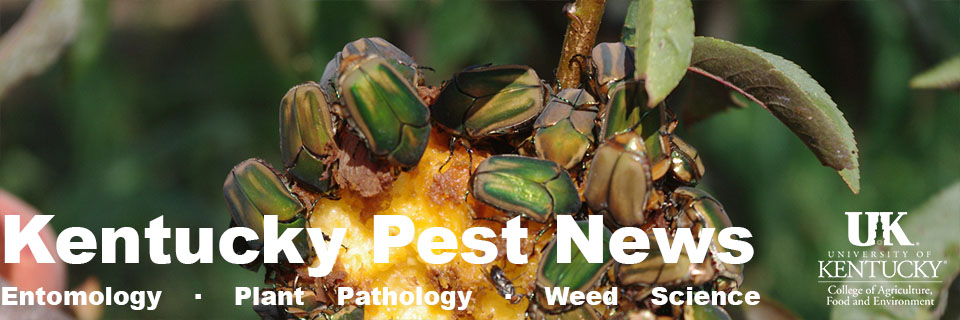A large number of Asian longhorned ticks (ALT), Haemaphysalis longicornis, has been confirmed from a dead calf in South Central Kentucky in March. Numerous ALT were also collected in and around the pasture. ALT, native to East Asia, was found…
Blog Archives
New Tick-Transmitted Cattle Disease Now Confirmed in Kentucky
This past week, there were two cases of Theileria orientalis Ikedia, a protozoan disease, reported in Kentucky. The reports came from two cattle, one in Fleming County and the other in Hart County. This protozoon attacks red and white blood…
New Tick-transmitted Cattle Disease Detected in Tennessee
Last week, on June 10, a herd of cattle in central Tennessee was reported to have Theileria orientalis Ikedia, a protozoan disease vectored by the invasive Asian longhorned tick. This protozoon attacks red and white blood cells and causes bovine…
Pasture Flies and Ear Tags for Cattle
Horn and face flies are two of the more problematic insect pests to manage in pastures. Without proper management, they can reduce cattle weight gain. Insecticide-impregnated cattle ear tags are practical, easy to apply, and can provide long term control…
Asian Longhorned Tick on Cow in Northern Kentucky
A large number of Asian longhorned tick (ALT), Haemaphysalis longicornis, has been confirmed from a dead, emaciated cow in Boone County on July. ALT, native to East Asia, was found in 2017 in the United States, where it infested sheep…
Flies and Pink Eye a Problem Again This Summer
Face flies are annoying pests for cattle that can impact the animal’s welfare by just constantly molesting the eyes of our animals. These flies are looking to feed on tears but will also feed on saliva, blood, and nasal discharges.…
Asian Longhorned Tick: A New Tick in Town
Ticks are always a concern for those of us who like to go outside to hike or hunt and for those of us who work in outdoor settings. Ticks are annoying blood thieves and they are also potent disease vectors,…
Insects in Livestock Feed and Hay
Insects show great promise AS sustainable food sources for fish, poultry, and swine. Some species can efficiently convert organic waste to nutritional supplements while significantly reducing its mass and making it unsuitable as a breeding site for pests. However, insects…
Sucking and Biting Lice
Lice are small, wingless, flat-bodied insects with legs modified for grasping hair shafts. They are generally host-specific. For example, cattle lice will not survive for long on swine. They are obligate parasites because they must have blood meals to develop…
Asian Longhorned Ticks Keeps Popping Up
Asian longhorned ticks (ALT) (Figure 1) are small, reddish brown ticks with no distinctive markings to aid in quick recognition. Unfed adults are smaller (3 to 4 mm long) than the other hard ticks that we commonly encounter. The 2017…
Rains + Heat = Fly Control Problems
Pasture flies (horn flies and face flies) and confinement flies (stable flies and house flies) need moist breeding materials. Horn flies and face flies develop in fresh cow manure; stable flies and house flies develop in mixtures of manure, decaying…
Black Flies
There has been a significant outbreak of black flies in the Arkansas delta this spring (see this article). In Kentucky, these biting gnats were attacking people last week in Jefferson County. Historically, black flies have tormented livestock along streams and…
Horn Fly: The $1 Billon Insect
Horn flies are important pests of pastured cattle (Figure 1). They use their piercing-sucking mouthparts to take about 30 blood meals every day. The almost incessant feeding of large populations can severely impact growing calves and lactating cows. Horn flies…
Cattle Lice
Lice may be the reason for cattle scratching to the point of rubbing off large patches of hair or creating raw sores. The biting and sucking lice that infest cattle are most numerous and active during winter and can spread…
Fly Strike in Calves
Calving presents the opportunity for fly strikes. Fly strike begins when a female blow fly, usually metallic green bottle fly, lays a small batch of oblong white eggs on an attractive site. These scavenger flies do not deposit eggs on…
